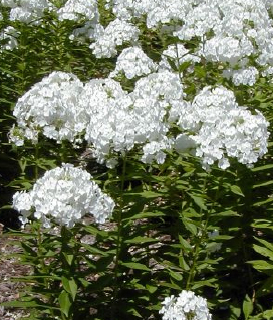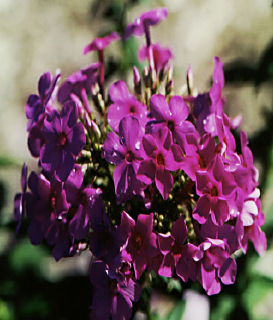|
Wilson
Bros. Observations
Tall garden phlox are a
beauty to behold - a must
in every southern garden.
The large flower clusters,
produced in abundance during
summer, are perched on tall
stems that rise just above
the dark green foliage -
or variegated foliage in
the case of 'Nora Leigh'
(shown below). Some are
sweetly fragrant, most make
good cutflowers, and all
are attractive to butterflies.
There are many new varieties
that have shown good resistance
to powdery mildew, as this
had been a problem in the
high humidity in the south.
Below are a few of the more
mildew-resistant varieties
that we try to keep in stock
at the nursery during the
season.
 |
|
 |
|
 |
|
 |
|
|
David |
|
Franz
Shubert |
|
Nicky |
36"
HT |
|
36-48'
HT |
|
24-26"
HT |
|
48"
HT |
Lavender-Blue |
|
White-
fragrant |
|
Pink
- fragrant |
|
Deep
Purple |
| |
|
|
|
|
|
|
 |
|
 |
|
 |
|
|
Nora
Leigh |
|
Red
Super |
|
Robert
Poore |
|
|
24"
HT |
|
28"
HT |
|
60"
HT! |
|
|
White
w/ eye |
|
Red |
|
Rosey-Purple |
|
|
Culture
Soil:
Well-drained, fertile is
preferred
Light:
Sun or Partial Shade
Usage
Tall garden phlox are great
additions to sunny perennial
garden or beds. Growing
from 2 to 5 feet in height,
they should be used in the
mid-ground or background.
If planted in containers
make sure the soil used
is a well-drained premium
potting mix.
Planting
- Plant this perennial as
you would most others making
sure that there is good
drainage. (Do not plant
in boggy or consistently
wet soils). Also, space
plants 2 to 3 feet apart
to allow for plenty of breathing
room. As with roses and
many other plants, overcrowding
garden phlox can promote
the onset of unsightly powdery
mildew during high humidity
times, though many of the
varieties we stock at the
nursery are quite resistant.
Dig the hole two to three
times the width and no deeper
than the rootball. Mix in
a good soil ammendment such
as Claycutter or Mushroom
Compost at a 50/50 ratio
with the soil removed from
hole. Place rootball in
hole making sure that top
edge of the rootball is
at or slightly above the
ground level. Backfill with
soil mixture to top edge
of rootball. For more detailed
instructions and a diagram
see Planting
Instructions for Perennials.
Care
Pruning
-
Pruning
is not necessary however,
cutting the plants back
by half their height after
the first flush of blooms
will often encourage new
blooms. When the plant has
gone totally dormant in
late fall or early winter
dead foliage can be trimmed
back to the ground.
Fertilization
- To enhance
flower production and good
health fertilize in early
spring and again in early
summer with a good flower
food such as Colorburst,
or an organic fertilizer
such as Milorganite.
Watering
- Once established, garden
phlox need little attention
to watering however, do
give them some water during
extended dry periods in
summer. You'll know they
need a drink if and when
the foliage wilts during
dry spells.
Known
pests and diseases: Powdery
mildew is the only problem
we've seen. Purchasing mildew
resistant varieties, spacing
adequately to provide for
good air circulation, and
not watering the foliage
in the late evening, or
at night, can prevent the
onset of powdery mildew.
| Companion
Plants for Tall Phlox |
| Shrubs
- Dwarf Spireas,
Dwarf Abelias,
Dwarf Gardenia,
Daisy Gardenia,
Dwarf Crape Myrtles,
Loropetalums,
landscape Shrub
Roses, and
most of all: Vitex
(Chaste Tree)
SEE: Flowering
Shrubs |
| |
| Ornamental
Grasses
- Maiden Grass,
Pampas Grass,
Zebra Grass, Muhly
Grass, and other
ornamental
grasses. |
| |
| Perennials
- Rudbeckias and
other daisies,
coreopsis, Russian
sage, coneflowers,
sedums and many
other sun-loving
perennials
or cutflower
perennials. |
| |
| Trees
- Crape Myrtles,
Japanese Maples
and other small
trees. |
| |
| Groundcovers
- Low Growing
Sedums, Dianthus,
Verbenas, Lantana
'New Gold', BlueStar
Creeper, and other
low growing perennial
groundcovers.
|
|
| |
All
About Perennials |